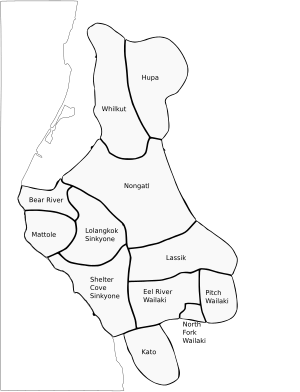Hupa language facts for kids
Quick facts for kids Hupa |
|
|---|---|
| Na꞉tinixwe Mixine꞉wheʼ | |
| Native to | United States |
| Region | California (Hoopa Valley) |
| Ethnicity | 2,000 Hupa (2007) |
| Native speakers | 1 (2015) |
| Language family |
Dené–Yeniseian?
|
Hupa is a special language spoken by the Hupa people in Northwestern California, United States. Its native name is Na꞉tinixwe Mixine꞉wheʼ, which means "language of the Hoopa Valley people." It is part of the Athabaskan language family, which has many languages spoken across North America. The Hupa language was traditionally spoken along the lower part of the Trinity River. Before Europeans arrived, other groups like the Chilula and Whilkut also spoke Hupa.
Contents
Who Speaks Hupa?
In 2000, about 64 young people between 5 and 17 years old spoke Hupa. Four of them spoke only Hupa. By 2012, fewer than 10 people could speak Hupa fluently. One of these fluent speakers was Verdena Parker. About 50 other people of all ages knew some parts of the language. Many more tribal members know a few Hupa words and phrases. People are working hard to keep the Hupa language alive.
Sounds of Hupa (Phonology)
Every language has its own unique sounds, and Hupa is no different. The study of these sounds is called phonology. Hupa has a special set of consonant sounds. These include sounds like 'm', 'n', 's', and 'l', similar to English. But it also has sounds that are not found in English. For example, some sounds are called "ejective" sounds. This means you make them by pushing air out quickly from your throat.
Hupa also has different vowel sounds. Vowels are sounds like 'a', 'e', 'i', 'o', 'u'. In Hupa, these vowel sounds can be short or long. The length of a vowel can change the meaning of a word.
How Hupa is Written (Orthography)
The Hupa language has its own alphabet. This alphabet helps people write down the sounds of the language. It includes letters you might recognize, like 'a', 'b', 'd', 'm', 'n', 's', 't', 'w', 'x', and 'y'. It also uses special letters and symbols to show sounds that are unique to Hupa. For example, 'chʼ' and 'tłʼ' are special sounds in Hupa. The symbol 'ʼ' is used for a sound called a glottal stop, like the sound in the middle of "uh-oh."
How Hupa Words are Built (Morphology)
Hupa words, especially verbs (action words), are built in a very interesting way. They are like puzzles where different pieces are added together.
Verb Themes
In Hupa, verbs start with a "theme." Think of a theme as the main idea or skeleton of a verb. You add different parts to this theme to create a full word. These parts are called prefixes. Prefixes are small pieces added to the beginning of a word. They can change the meaning or how the verb is used.
For example, a theme might mean "to fill." Then, you add prefixes to show who is doing the filling or what is being filled.
Verb Structure
Hupa verbs are made up of a main part (the verb stem) and many prefixes. These prefixes are added in a specific order. Some prefixes are "disjunct" and go at the very beginning. Others are "conjunct" and go closer to the verb stem. This system helps to add lots of information to a single verb, like who is doing the action, when it happened, and how it happened.
Pronouns in Hupa
Pronouns are words like "I," "you," "he," "she," "it," "we," and "they." In Hupa, pronouns are often added as prefixes to verbs. This means you don't always need a separate word for "I" or "you" when you are talking about who is doing the action.
For example, a prefix might tell you that "I" am doing something, or "you" are doing something. These prefixes change depending on who is speaking and how many people are involved.
There are also separate words for pronouns, like whe꞉ for "I" and ning for "you." However, these separate words are not used as often as the prefixes. Instead, Hupa speakers often use "demonstrative pronouns."
Demonstrative Pronouns
Demonstrative pronouns are words like "this," "that," "these," and "those." In Hupa, these words are used a lot. They help to point out people or things. For example, hay-de꞉ means "the one here," and hay-yo꞉w means "the one there (close)." These words help to show where someone or something is located.


